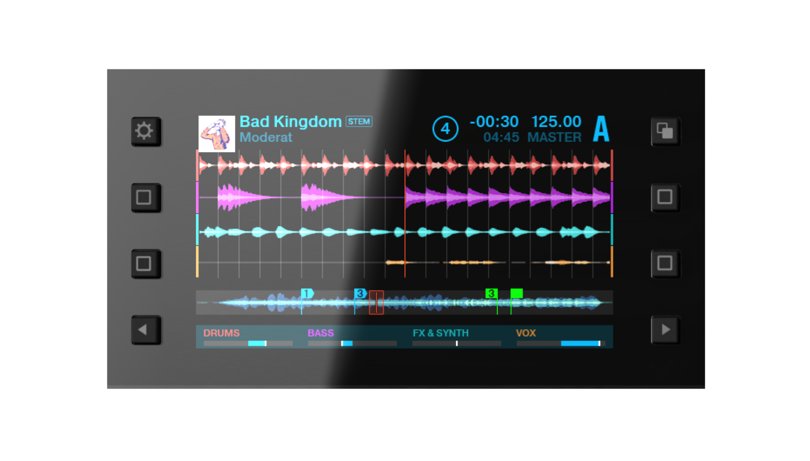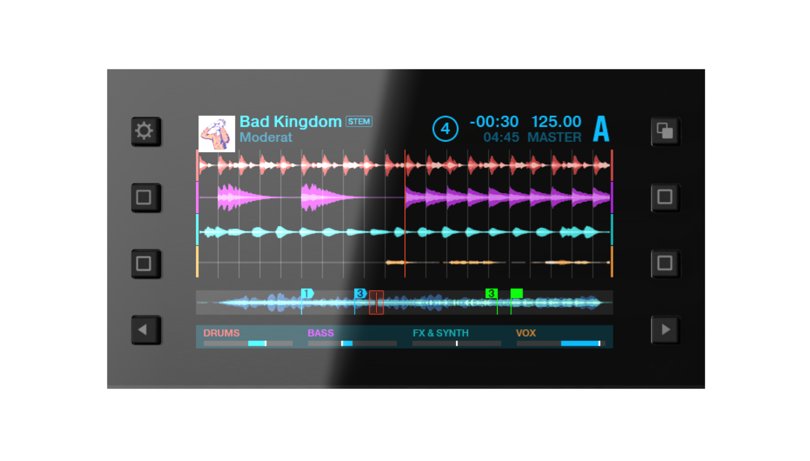Reviewed: Native Instruments’ – Stems

Native Instruments have had a fair crack at reshaping the dance music world over the last decade. It’s fair to say that dubstep wouldn’t have sounded the same without the ubiquitous bass wub of their VST Synth Massive, and their DJ software, Traktor, has risen to stand alongside Rane’s Serato system as the default interface for laptop DJs.
Whilst Serato has concerned itself with a ‘purer’ approach to digital DJing, where more emphasis is placed on using platter controllers, be they CDjs or turntables, Traktor has carved out its name by combining old school platter based techniques with a focus on the potential offered by loops, sync locks and effects. In keeping with this desire to push the art forward, their latest attempt to redefine digital DJing is the much heralded introduction of the Stem system.

The concept is pretty simple – a clutch of major dance labels – including luminaries such as R&S, Hot Flush, BPitch, Turbo, Minus – have been persuaded to release their new tracks in the stems format alongside traditional mp3/wav releases. Stem tracks have been split into 4 separate parts, typically drums, bass, vocals and percussion/synths. When loaded into the latest version of Traktor (2.9 if yer counting), the stem track appears as normal – as a single waveform representing all four tracks together – essentially indistinguishable from the track in normal mp3 format. When you hit play (or trigger the track with a timecode CD/vinyl) it plays as normal, with all 4 parts playing simultaneously, and you hear the track as you’d expect. However, introduce one of Traktors new hardware controllers, with their 4 separate faders, and you can individually control the volume and effect settings of each of these parts. Get your hands on the Kontrol D2 or S8 and you also get a decent sized screen that shows each of the four tracks as they run along, like so:

Essentially you can use the faders to dub out tracks live, for example, pulling out everything but the drums or vocals (or both, what the hell, eh). Upon first seeing the system I was somewhat cynical – isn’t this just replicating the EQ based isolator switches that have been around since Larry Levan’s day? But it turns out that’s not really the case – for example, you’d be hard pushed to find an EQ sweep that can completely kill a tracks bassline whilst leaving the drums (let alone everything else) completely untouched. Vice versa, the ability to suck out everything, bar, say a synth lead, has previously been impossible to do with any clarity.
However it’s when the effects are bought into play that the units come into their own – the ability to add multiple effects to individual stems whilst leaving the rest unaffected opens up a host of creative possibilities. For example, you could run a pitch transpose effect on a synth stem, allow you to pitch it up and up, whilst the rest of the tune plays unaffected underneath. Pull the kicks out while you’re doing this, then slam them back in at the same time as punching off the transpose effect and you’ve created an instant, unexpected build and drop.
Obviously there’s healthy potential here for innovation, both in messing with a track as it’s playing, and coming up with some unique transitions. I love the idea of cutting between two vocals so they ‘converse’ with each other whilst the rest of the track remains untouched. And the ability to mix just the bassline from one tune over the drums of another is something that’s entirely new. I should note that within minutes of dicking about with the S8 my cynicism had been swiftly replaced with the urge to sack off work and twiddle knobs all day. For anyone with a basic working knowledge of Traktor the kit is super-intuitive and genuinely fun to use.
But, inevitably, there are drawbacks to the system. Obviously not every track lends itself to being stripped down to 4 parts. Whilst Stems is a minimal DJs dream, if you’re playing lush disco epics, or multi-layered trap, the system is going to struggle to offer much more than separating out drums, bass, vocals and everything else. There's also the problem in depth of catalogue. At the moment there's only about 10-20 tracks in the stems format available that I'd conceivably want to play – the situation is similar to owning a video player in the early 80s – it was all good if you wanted to get dumb watching Rocky III, but you were going to have to wait years before you could catch some Pedro Almodóvar. And whilst as a producer you can create and play your own stems, Ableton and (Traktor's remix decks) have allowed that functionality for some time now.
Realistically, the format is only going to be as good as it’s take up. If enough labels embrace stems, then it’s likely to grow at an exponential rate – the more material there is out there, the more appealing the system seems, the more labels will take it up. It’s not inconceivable that if very successful, stems could encourage producers to substantially shift their approach to sound design, creating tracks specifically to appeal to the split stem set up.
So currently, for producer/DJs there's probably enough going on to warrant buying one of the two bits of kit that works with Stems – the D2 comes in at a bit under £300, whilst the S8 is closer to £700. It's infinitely more fun to use than Ableton (which, I personally feel should never be seen in a DJ set), and very intuitive to use – the ability to remix your tunes on the fly to respond to the crowd is inarguably an attractive one. But for DJs who just play other peoples tracks, I’m not convinced it’s currently much more than a fairly expensive toy. There’s only about 1000 songs available, and if you’re after stuff beyond the remit of Beatport chart busters you’re gonna be disappointed. This time next year though, well, we'll see. It’s early days yet, and I get the feeling that the idea of selling tunes as synced, remix-able components– and being able to sell them for more cash as a result – is going to grow and grow. It may just be that Native Instruments have changed the game once more.


















Must Reads
David Holmes – Humanity As An Act Of Resistance in three chapters
As a nation, the Irish have always had a profound relationship with the people of Palestine
Rotterdam – A City which Bounces Back
The Dutch city is in a state of constant revival
Going Remote.
Home swapping as a lifestyle choice
Trending track
Vels d’Èter
Glass Isle
Shop NowDreaming
Timothy Clerkin
Shop Now